The most direct way for clients to sync their calendars with CoachAccountable is to use the Google, Outlook, or iCal sync.
This enables CoachAccountable to automatically add whatever appointments get scheduled to the calendar of choice and, in the case of coaches, read their availability for the sake of avoiding double booking.
But sometimes clients can’t be bothered. For some it’s an extra step that they just don’t (or won’t) get around to. For others it might be concerns over security, sometimes based on corporate IT policy or the like, that make full-on calendar sync a non-starter.
Calendar Invitations via Email
CoachAccountable also provides for a robust (yet totally passive) approach. Clients can receive calendar invites by email for all appointments you schedule with them, meaning those appointments will be automatically added to their calendar as those email notifications are received.
Likewise, calendar invites can also describe (and affect) changes to previously scheduled appointments, namely rescheduling and canceling.
Calendar Sync Options for Clients
Your clients have three calendar sync options to choose from. Your clients will find these when logged in under My Account >> Calendar Sync:
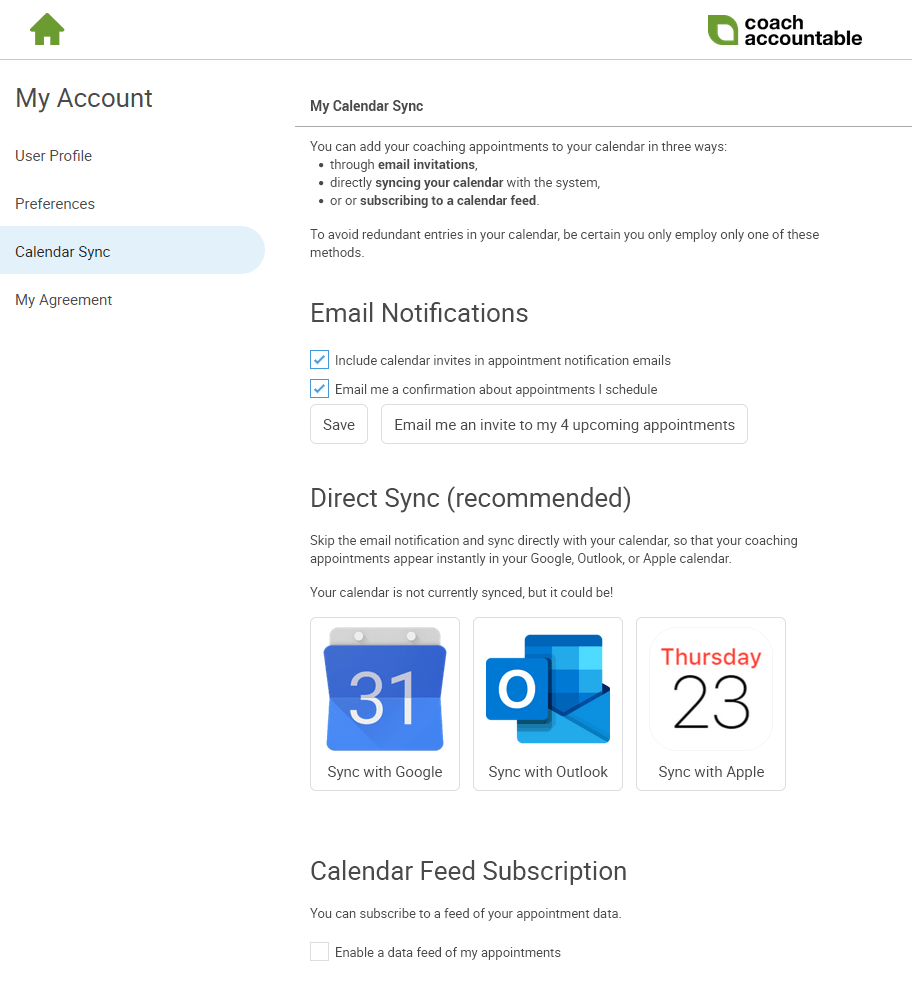
Specifically, the Email Notifications section:

Include calendar invites in appointment notification emails allows clients to opt into getting those calendar invite attachment files at all, receipt of which generally has the effect of automatically adding appointments to a related calendar.
In addition to notifications about newly scheduled appointments, these invites will be attached to notifications of rescheduling and canceling, meaning those calendar entries will be updated (and removed) as needed, too.
Email me a confirmation about appointments I schedule allows clients to opt into getting emails about things that they themselves just did. If not for the calendar-syncing aspect, these emails are largely redundant: client schedules an appointment, they can see from the app UI that they did so, and then an email announces essentially “hey, you did the thing you just did”.
BUT this becomes really handy when that email contains an attachment that automatically adds the newly-scheduled appointment to their calendar. In that case, it serves as far more than a recap of what just happened.
These confirmations of client activity extend also to rescheduling and canceling: each action will trigger a corresponding email confirmation, and if including calendar invites are opted for (that first check box), then the attached invites will also have the effect of updating (and removing) appointments from their calendar.
Note that these email notifications for calendar sync are enabled by default for all new clients.
You as coach can see and set the Email Notification settings for your clients. Find these in the Client Manager, under Settings >> Appointments:
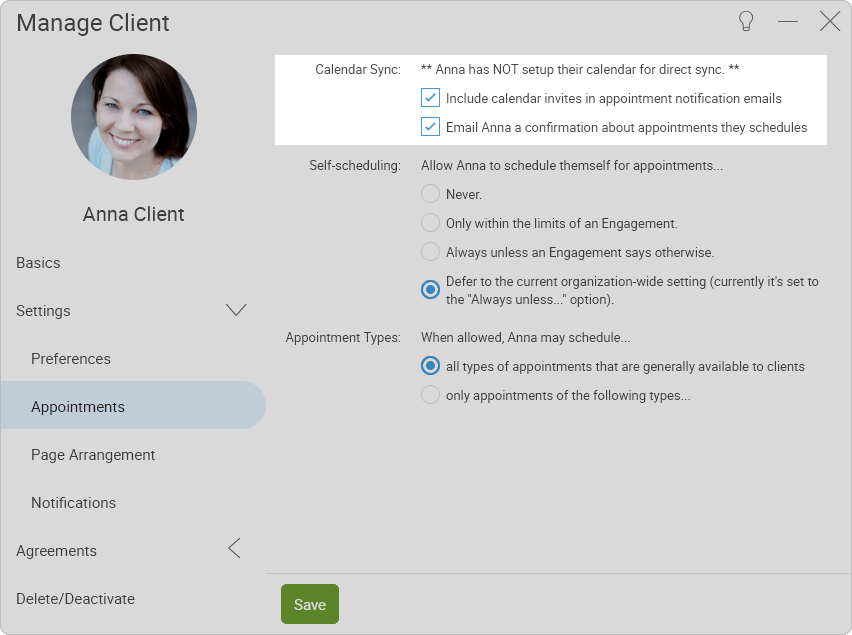
From here you can see whether or not your client has already set up their calendar for a direct sync. If they haven’t, it’s probably a good idea to have both of those check boxes checked.
When Notifications are Sent
If receiving calendar invites via email is the main mechanism for your client to keep their calendar in sync, it’s important that they get an email notification for every appointment that gets scheduled (plus any and all rescheduling or canceling thereof).
Again, when client opts for the “Email me a confirmation about appointments I schedule” option, they’ll get suitable emails whenever they do the scheduling, rescheduling or canceling. But what about when you as coach do those things?
When you schedule, you also have the option to send a notification to your client, like so:
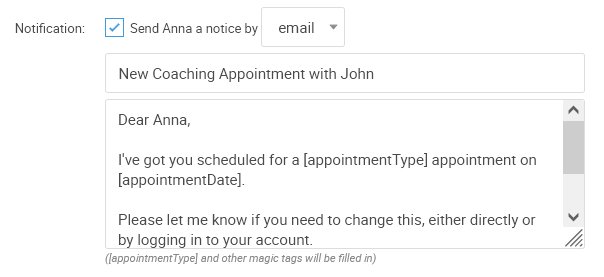
You’ll generally want to send the notification, and do so via email. Be aware that deviating from that process can undermine that calendar syncing behavior.
The same applies for when you as coach reschedule or cancel an appointment with your client: you’ll have the option to notify your client of the change via email, and for the same reasons doing so is highly recommended.
Appointments for Offerings
The same “auto add to calendar by email”-behavior applies to any appointments scheduled by way of signing up for an Offering.
With Offerings you can opt to have a Confirmation Email sent when someone successfully signs up for it:
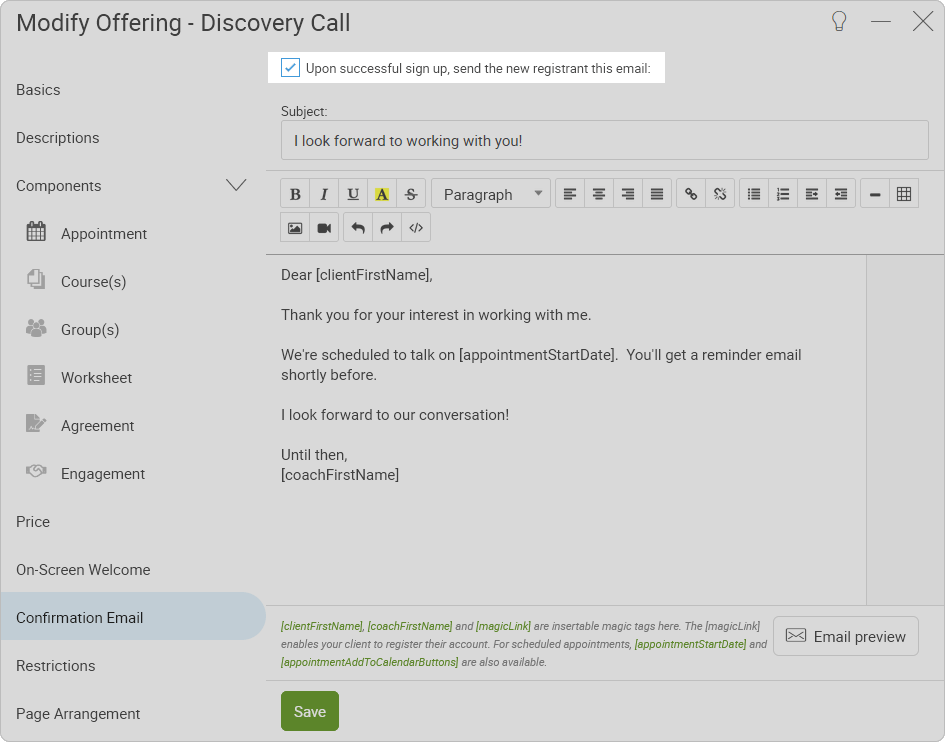
If you opt for this email to be sent, AND the Offering entails scheduling an Appointment, that email will automatically have a suitable calendar invite attached (thus automatically adding it to your new client’s calendar).
And if you DON’T have a Confirmation email set for an Offering? In this case, CoachAccountable goes a little off script and sends a standard Appointment Notification email (with the calendar invite) instead. The verbiage for this email is taken from your Appointment Notification email template, so it’ll still be on brand.
You can include or exclude those "appointment add to calendar buttons" consistent with your taste, sensibilities around clutter, and how much you do or don’t trust your clients to show up like responsible adults (in some contexts this can’t always be taken for granted!).
Email Invites for Group Appointments
Just like with one-on-one appointments, when you as coach schedule (or reschedule, or cancel) your Group Appointments, the notification emails that you can (and probably should!) opt to send will similarly come with suitable calendar invite attachments, allowing all client members (who are included in that Group Appointment) to have that appointment automatically added to their calendars.
One caveat to this: the system will NOT email newly added group members that happen to be auto-added to future Group Appointments. That could be a surprising gotcha, and generally speaking CoachAccountable avoids sending emails to clients on your behalf without some form of your express intent to do so.
Email Invites for Appointment Series
As always, you as coach can schedule a series of Appointments with your clients or groups:

When you do so, the notification email body (that your clients will read) will contain details only about the first one. BUT the email invite attachment includes information about the whole series, meaning each appointment in the series will get added to your client’s calendar.
Getting Caught Up or Re-syncing
At any time, your clients can visit their My Account >> Calendar Sync page, and if they have future appointments they’ll see an “Email me an invite…” button like this:
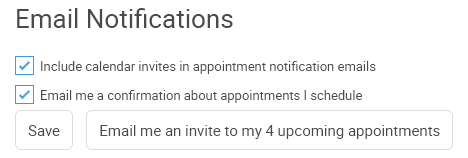
Clicking that will cause CoachAccountable to email them an attachment with a calendar invite file containing data for all of their future appointments, allowing them to quickly get those appointments into their calendar.
You too, as coach, can have this email sent to your client. For a client that has one or more future appointments, you’ll find the button to do so among their calendar sync settings (again, you’ll find this in the Client Manager, under Settings >> Appointments).
Use Caution When Deleting via Calendar
One gotcha to this: it can be fun to try deleting an appointment from your calendar and then sending this email to enjoy seeing it magically re-appear. The problem with that is many email calendar systems will keep note of the fact that you specifically removed an appointment already, prompting it to NOT re-add it when it arrives again via email. So delete appointments added in this fashion at your own risk: the calendar invite approach may not be able to restore it!
Instead, remove appointments from within CoachAccountable, rather than from your calendar.
In Summary
Yes, the direct sync is more elegant and robust, allowing your client to skip the clutter of extra emails that might be largely redundant. But with email ICS attachments, your clients can have those appointments with you appearing in their calendar from day 1, with no effort on their part required. And for those clients who want the elegance of direct sync later, they can do that as a separate step whenever they feel so inclined.